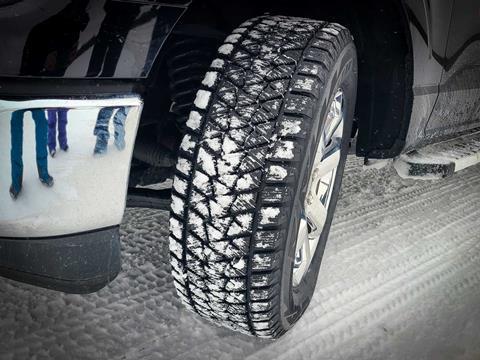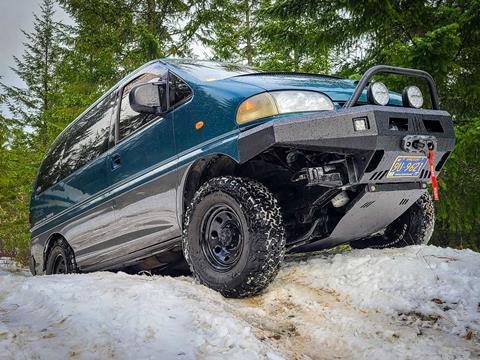Growing up in Minnesota, harsh winters were inevitable. Below-freezing temps, arctic-like windchills, and icy road conditions meant you and your vehicle needed to be ready for the worst Mother Nature could dole out.
If unprepared for the weather, a mechanical problem might not just be an inconvenience, it could be a life-or-death situation. During my 28 years in the Midwest, I learned the ins and outs of cold-weather vehicle preparation and how important it is if you’re venturing into freezing environments.
Let’s take a look at some of the things you can do to get your rig ready for Old Man Winter.
Check Your Fluids
The most basic thing you can do is to make sure your vehicle’s fluids are up to snuff. This means testing your coolant and cooling system to ensure it’s ready for the cold you’ll encounter.
Basic antifreeze testers are cheap and worthwhile. And while many don’t associate overheating with cold weather, it’s more common than you’d think. After all, coolant that’s frozen solid won’t flow and won’t cool.

Changing your vehicle’s usual 50/50 mix to, say 60% coolant and 40% water, can help to make it more effective in the coldest conditions. Also ensure your coolant is topped off and the radiator, cap, and hoses are in check and without cracks or leaks. Remember: this system also provides your cabin with heat!
Seeing is, you know, kind of important—especially on snowy roads. Make sure your wiper fluid is good for cold temps. Wiper fluids have a temperature rating. All-season fluid is usually good to 32° F, but some of the coldest fluid is rated to -30° F. Before we headed up to the Arctic Ocean in February of 2020 on the Alcan 5000, I replaced my vehicle’s fluid and replaced it with juice that was good to -30° F.

There are plenty of other fluids to check before winter hits. This includes gear oil, transmission fluid, brake fluid, and of course, your motor oil. Speaking of, our old 1991 Mitsubishi Pajero diesel uses 15W40. Before heading into the wintery arctic, we changed to 5W40—a lower cold-weather viscosity.
Getting The Most Traction from Your Tires
Having good tires (and the right tires) for winter can make a massive difference in traction. No matter which kind of tires you have, ensure you’ve got adequate tread depth. However, in temperatures colder than 45°F and in snow, slush, and ice, a winter tire will provide the best traction possible. This is due to different tread patterns and rubber compounds that handle the cold better than all-season, all-weather, or summer tires.

While a dedicated snow tire will provide optimal cold-weather traction, tires with a 3PMS (3 Peak Mountain Snowflake) rating will provide the next-best cold-weather traction. Many all-terrain and all-weather tires will have the 3PMS rating. All-season tires with an M+S (mud and snow) rating would be next best (although not optimal), followed by the worst option, a dedicated summer tire (not usually an issue on adventure vehicles).
Also remember, as the temperature drops, so does your tire pressure. Check this as the weather gets colder so you’re still running at your vehicle’s recommended PSI.
Auxiliary Engine Heating
Depending on how cold it gets where you take your vehicle, your rig might benefit from auxiliary engine heating. These come in a variety of forms.
The most common—especially on older vehicles—would be a block heater. These are electrical heating elements put into an engine’s block (of often inserted into a freeze plug) that heat up when plugged into A/C power. The element warms up and keeps the engine block warm making the engine easier to start.
Oil pan heaters are also commonplace. These rubberized pads are slapped onto the engine’s oil pan using an adhesive. This helps to keep the oil viscous and free-flowing. These are particularly good for diesel engines that can often run a higher viscosity oil, such as 10W40 or 15W40, that can be like molasses in the cold. They’re also usually inexpensive and can just plug into a 110V A/C power source.

The more advanced way to keep an engine warm is by using a coolant heater. These units, such as the Webasto Thermo Top Evo, are about the size of a lunch box, and are plumbed into a vehicle’s cooling system. When the vehicle is off, a pump circulates coolant through the engine block and fuel from the vehicle’s tank is ignited to warm the antifreeze.
This warming and circulation keeps the engine at operating temperatures when the vehicle is off. When it comes time to start the engine, it should fire up much easier. Our Thermo Top Evo made it possible to start our old 1991 Mitsubishi diesel engine in temps as low as -43° F when in Inuvik, Northwest Territories.
Battery Basics
Cold weather can be rough on car batteries. So before the temp plummets, ensure your battery is in tip-top shape. Your vehicle will need all of the cold-cranking amps (CCA) it can use in frigid temps.

If using a serviceable lead-acid battery, make sure your battery’s water is topped off. Clean corrosion off the terminals. If you think the battery is on its way out, have it tested; most auto parts stores will do it at no cost.
If the battery is not long for this world, replacing it before the winter is a great time to do so. Get an appropriate battery with the most CCA as possible. This will give your vehicle the best shot at starting in the coldest environments.
Fuel Additives
There are some vehicles that may benefit from fuel additives, especially if you have a diesel. Things like cetane boosters and anti-gelling additives can be crucial for diesels in cold weather. Gasoline-powered vehicles often don’t need fuel additives.
However, on occasion, gas-line antifreeze products, such as HEET, can help prevent fuel lines from freezing up as the product removes water from lines. Keeping your fuel tank on the full side can reduce condensation in the tank, and also reduce the risk of any issues with water in the fuel lines, too.
Other Miscellaneous Winter Must-Haves
There are a few other miscellaneous things to check before winter sets in. Replacing your wipers is a great idea, especially with stouter winter versions. These types of wipers have a plastic or rubber cover over the wiper’s frame to keep ice from building up. Even a fresh set of normal wipers is a good idea.

Growing up in the Midwest, many of us carried a bag of kitty litter. This isn’t for weight, but rather traction. Dumping some of the material around the wheels with power can add the grip your rig might need to get unstuck. Speaking of, having recovery gear onboard can also help. This includes traction boards, making sure your winch is in working order, and having the right kind of shackles.
There are also some common-sense things to bring during wintertime trips, too. This includes plenty of warm clothing and boots, extra food and water, flashlights or headlamps, a sleeping bag (in case you need to spend the night in the car), hand warmers, and a blanket.
As they say, an ounce of prevention is worth a pound of cure—and a little bit of winter vehicle prep definitely goes a long way to a safe, comfortable, and confident winter travel.
Sign Up For the OVR Trailhead Newsletter
The OVR Trailhead brings you relevant vehicle-based adventure stories and offers direct to your inbox. Join the OVR community today!
Access More Great Stories!
For more informative articles like this, consider subscribing to OVR Magazine in print or digital versions here. You can also find the print edition of OVR at your local newsstand by using our Magazine Finder.





















No comments yet